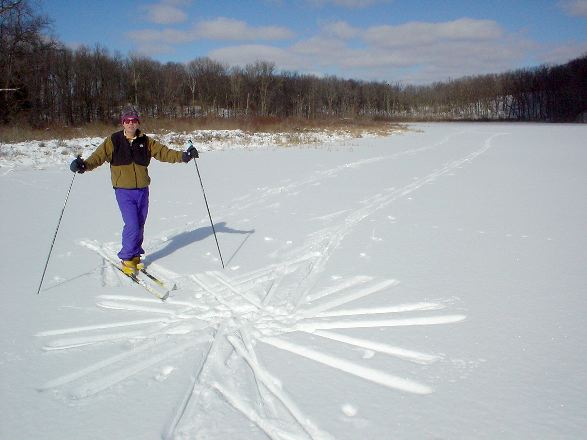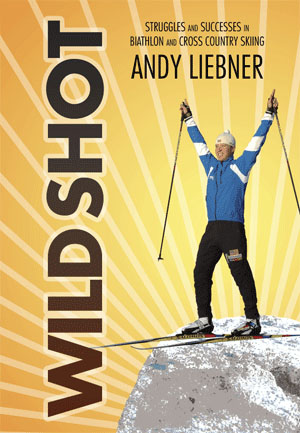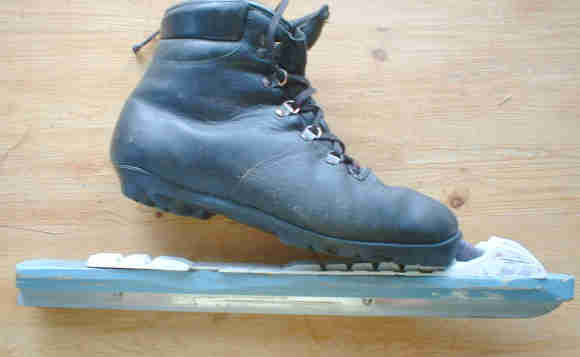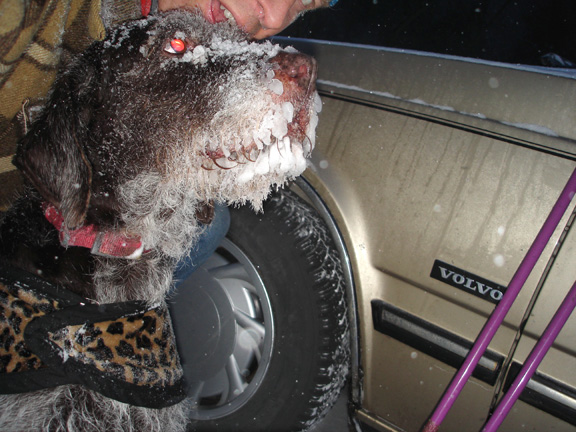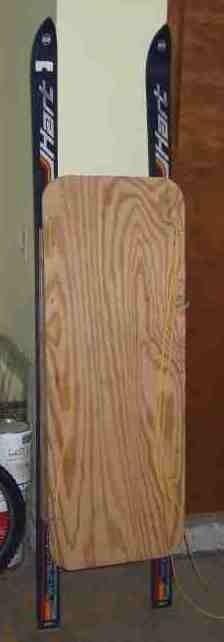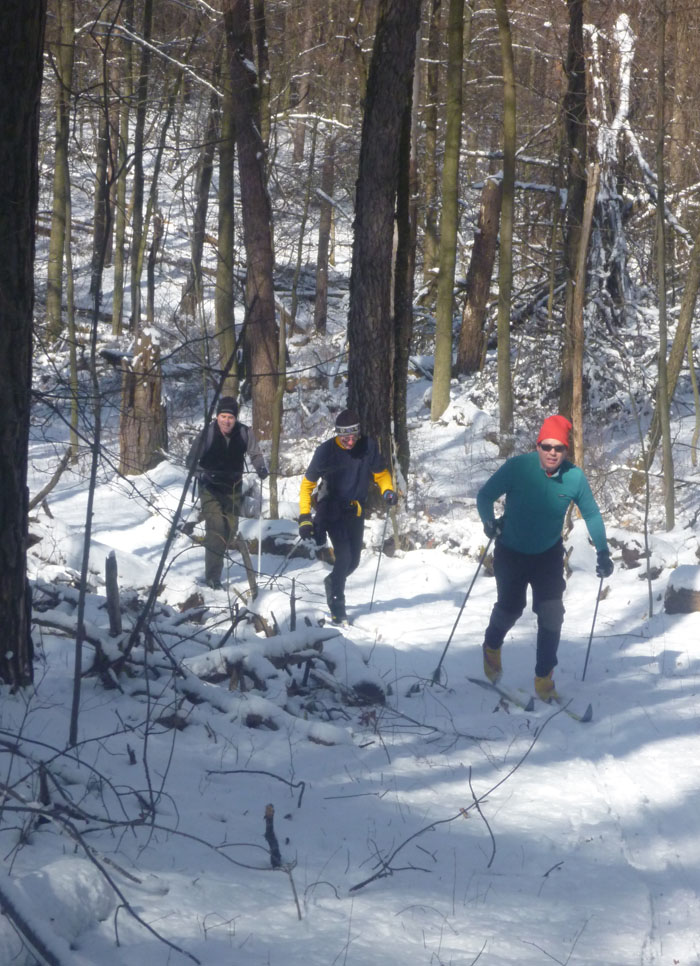Picture an out-of-town skier peering off a groomed track into the fluffy unknown. —If I’m brave enough to step out there into the wilderness will the skis work? Will I get lost? What will happen to me?
This is how ski-touring is sometimes presented nowadays. Like it’s a new thing that people are both curious and uncertain about.
I’m sure that skiing off a groomed track is unusual for some people. But ski-touring is actually the most versatile, affordable and common kind of skiing!
A newbie raised on groomed trails may not know this, but they have a lifetime of free-range fun in store for them if they’ll only just ski where they please!
Stepping off the groomed track doesn’t mean you end up off the map. Ungroomed skiing includes skiing on all the myriad of other kinds of trails—self skied-in trails at local parks, golf courses, fields and farms. It includes hiking, biking and multi-user trails. It’s mostly near home. It’s mostly mellow terrain. A half-hour to half-day is how long we’re typically out there.
I personally rarely ski on groomed trails. I live in mid-Michigan and my town has a dozen great hiking trails, parks and golf courses that are within 5 minutes of home. I use an all-round modern full-length set-up with a moderately wide ski and mid-range supportive boot. I see dozens of other skiers out there, too. I feel that my approach gives me ski-racing performance out of almost all my day-touring. I just love it. I love to glide-out and float up the hills. I do it on any old trail. I don’t even need a trail at all. I know where I live—it’s not intimidating. Skiing sets my winters free! And my all-rounder rig sets my skiing free! I do tele-turns on mellow hillsides. I stop for snacks and picnics. I explore and wander. I can do skate-skiing when the trail widens out. The ticket to admission for this wide-open type of skiing is simply an all-rounder ski rig. And I surely don’t need groomed trails to do any of this.
[DAYTOUR TIP: Use a narrow hydration-type backpack on top of a fanny pack to make a nifty 2-part stacking system. While you’re under way you can easily get at water bottles and swing your fanny pack around to get at map, snacks, camera and waxes. The pack holds lunch and dry clothes. Stopping and starting uses up TONS of time on a dayski. That’s why waxless skis can be as fast as waxable when you’re out all day—stopping to rewax as the sun goes up and down costs more time than the faster wax saves. Also, narrow hydo-packs don’t sweat up your back as much as regular rucksacks do. And you’re not tempted to bring more than 5-10 lbs of stuff! Keeping water thawed is a vital side topic. If you use a bladder you might need to put foam pipe insulation on your sippy tube—or figure out how to route it into your clothes. Strategically placed heatpacks can also come in handy! If you use water bottles in holsters on a fanny pack, turn them upside down and lightly tape heatpacks in the bottom of the holsters. Clever! Don’t overtape, as that cuts off air supply which stops the heat-action.]
Ski-touring is what most people know and grow up with—it’s what they see being done on the outskirts of town; it’s what their friends and family show them.
Groomed and other kinds of skiing, like tele, or “jibskate” (?) are surely the fringes in terms of all the XC skiing being done.
The dyno ski-handling involved in ski-touring is such great fun. I find it to be like singletrack action mt-biking. Only moreso. Offhand, it seems like more mt-bikers (and roadies, too) would be skiers. In some places there’s a lot of crossover. But it seems like too many wonder what to do in the winter. If they’re in snow-country, I know what they could do! It also seems like the snow-shoe scene has edged in on the bike/ski relationship—two dyno-flow sports that go so well together. Shoeing has a sweet float and it’s peaceful and it’s nice exercise. But is it dyno? Not!
I occasionally enter a ski race. I find that my day-touring is fine training. It only takes a couple outings with my race equipment to get reacquainted with it. The boost in speed when I do get into tracks with my ultralight rig is a blast!
I also know of a few informal ski-tour races that are held on hiking trails. These tend to be long, tough, self-supported—and great fun! Offhand, they seem to offer a lot of the true spirit of carefree outdoor adventure and camaraderie. The mt-bike scene seems to be more into this kind of thing and not surprisingly one of the events is organized by bikers…who still want to cruise their favorite trail even in winter. Who needs grooming?
Ski-touring includes a whole range of approaches from what is called Light Touring to heavy-duty Backcountry. There’s no real dividing line or even solid definition. Terrain, conditions and how long you’ll be out all determine how you’ll ski.
Ski-touring gives you all the trails and terrain of your summers—but with the all-new views that you can only get in winter. And the air is fresher! Everything is brighter!
In springtime we get the Crust Season where for a couple weeks we can ski anywhere at all. This is when I do most of my skate-skiing, over hill’n’dale—so that’s ski-touring, too.
Bring a map and compass for new country and a basic dayhiker’s set-up and skillset and you’re set. If it’s a familiar trail, just do as you normally do in summer, only with GLIDE! If you’ll be out awhile bring a snack…or picnic! A dry top, extra hat, and something padded to sit on can be nice, depending on how long you’ll be out. I find that 10 pounds is the most I like to ski with for a few hours. A couple pounds when I’m out on shorter jaunts. But then I like to stretch out and get tasty glide on the hiking trails I ski on.
A middling-wide ski is all you need to open up the world of trails in winter. I greatly enjoy my full-length skis, but I hear that mid-lengths are coming on. I can see them being good for tight, twisty trail action—where handling is as important as glide. I go waxable 90% of the time but occasionally waxless is the thing. 60mm of ski width will float pretty good in unbroken snow. 55-65mm will handle any previously-used trail. Skiers, hikers, shoers and snowmobilers all make a good ski trail if you have an all-round set-up. Use a ski with a metal edge if ice and steepness are part of your scene. Go wider the more weight you’ll carry. It’s not rocket science. The more challenging the terrain the more boot support you’ll want as well, but a light, low boot is fine for most terrain. New-era boots and NNN/SNS bindings are basically all supportive enough, even in light racing models. Add a gaiter for fluffy stuff.
If you like to go out for a few hours, try to save even ounces if you can on all your equipment, in mellow terrain. A light set-up will save a couple pounds overall and a heavier rig won’t improve anything. You’ll really appreciate light gear and stiff poles if you like to “swing out” with your skiing.
I also note that even lightweight touring gear seems to last forever, while racing equipment can be fragile. Still, I prefer race-weight poles. I’m careful and watch it when I crash so I can keep enjoying such fine pole action.
When it’s been cold and down in the 20’s for a couple weeks you also get the freedom of the wide-open WATERWAYS. Skiing on a snowy, frozen lake, pond or river is a lovely thing indeed. Our trails are mostly wooded, so I love also skiing out on the lakes where the sky opens up. (If it’s cold but there’s no snow, get out your skates!)
Most ski-touring rigs also work fine in groomed trails. Wider skis just aren’t as fast as narrower ones. But they’ll handle challenging groomed trails more easily than racing skis. And I have to emphasize that groomed trails are scarce compared to all suitable trails.
Occasionally a day-tour skier wants to go onto truly unbroken trails or untrammeled terrain. Most don’t fret about it. Just ski! It’s not done that often because you don’t get the glide but it’s still fun. Slap on gaiters, if you care. Ski your trail again the next day and you have a ski trail!
Ski-touring is about trying new things. If one is cautious, it lends itself to a stepwise, gentle learning curve. If one is gonzo, ski-touring is ready to deliver the works—fast action, big speed, turns, jumps, all-day exploring or even multi-day.
Groomed trails are fine, but ungroomed action offers unfiltered contact with the landscape—and the culture, too. There’s no machinery and resort management and service expectations between you and where you wander. When ski-touring you might ski alongside a busy neighborhood, past a sledding hill full of kids, down a farm lane lined with cattle, out over a frozen marsh and on into a wooded area you’ve never explored before—free of charge, no customers anywhere around.
You may well discover a sense of stewardship with the free-range areas or self skied-in trails you frequent the most. And a pocketknife or folding saw may well find its way into your daily kit, to help keep a hiking trail free of brambles and deadfall in the winter. You might even start lining out your own trails or keeping an eye out for a sweet new run down a woodsy hillside—if only a bit of dead brush was cleared. With a good eye and the singletrack spirit, trails can be easily created that leave no trace.
…Of course you’ll be skiing where it’s OK to and only trimming brush or moving logs to the extent that’s reasonable or legal…right?
If the snow is over knee-deep or the terrain brushy then get out your snowshoes. (I prefer wood ones for max flotation.) If there are hills or it’s steep the shoes are still great but if you want to make turns your 60-mil’s will get by. If you want to really shred, go wider, with beefy boots and maybe edges…you just won’t be able to glide up as well or stride out the valleys.
However, if you live in mellow territory and want to glide-out and want to buy a new full-length touring ski you might have a hard time. There aren’t very many offered.
Ya know, can ski-touring even be measured? You could look at outright sales to unaffiliated buyers, but does this tell you how much skiing is being done? In contrast, the beginner-level market, with its low expectations, that serves resort/rental/class activities is easily measured and organized. This might be why free-for-all ski-touring might not get as much respect in the market despite ease of entry, a quick learning curve, and a multitude of folks skiing in their backyards—indeed, despite it being the longterm core of the sport.
In terms of ease of service and profit per account, unaffiliated skiers—who will use ski-touring rigs nearly always—might tend to become less important to the industry even if they’re more common. They keep their skis too long, for one thing. The US XC market has perhaps changed a lot in recent decades.There are probably fewer independent retailers than in the early 80’s, and many sales might happen in a quasi-self-serve big box setting. This might also change the type of ski being sold. A short ski and a tall boot might be more appealing to the un-informed even if it doesn’t work as well.
Ski-touring is popular because it’s liberating. This is different from having an image of liberation. However, liberation isn’t easy to optimize. Business can serve it, but it’s hard to control, and control is the goal once business becomes big. The ski biz has done a lot of consolidating lately. Big biz depends on image…which actually often works against liberation. But skiing is free! We need an independent media and culture to keep us aware of this!
